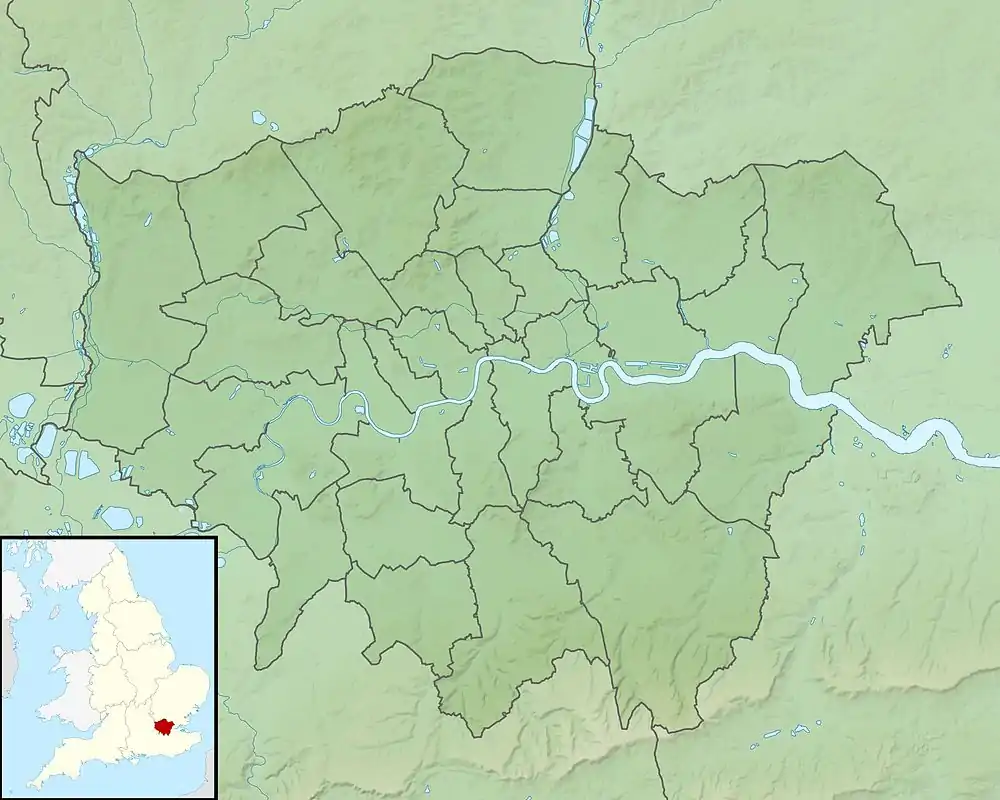London Borough of Southwark
The London Borough of Southwark (/ˈsʌðərk/ (![]() listen) SUDH-ərk)[2][3] in south London forms part of Inner London and is connected by bridges across the River Thames to the City of London. It was created in 1965 when three smaller council areas amalgamated under the London Government Act 1963. All districts of the area are within the London postal district. It is governed by Southwark London Borough Council.
listen) SUDH-ərk)[2][3] in south London forms part of Inner London and is connected by bridges across the River Thames to the City of London. It was created in 1965 when three smaller council areas amalgamated under the London Government Act 1963. All districts of the area are within the London postal district. It is governed by Southwark London Borough Council.
Southwark | |
|---|---|
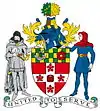 Coat of arms  Council logo | |
| Motto(s): United to Serve | |
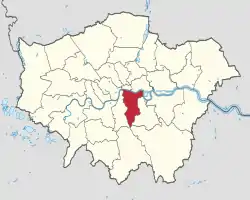 Southwark shown within Greater London | |
| Sovereign state | United Kingdom |
| Constituent country | England |
| Region | London |
| Ceremonial county | Greater London |
| Created | 1 April 1965 |
| Admin HQ | Tooley Street, Southwark |
| Government | |
| • Type | London borough council |
| • Body | Southwark London Borough Council |
| • Leadership | Leader & Cabinet (Labour) |
| • Mayor | – (non-political) |
| • London Assembly | Florence Eshalomi (Labour) AM for Lambeth and Southwark |
| • MPs | Harriet Harman (Labour) Neil Coyle (Labour) Helen Hayes (Labour) |
| Area | |
| • Total | 11.14 sq mi (28.85 km2) |
| Area rank | 303rd (of 317) |
| Population (mid-2019 est.) | |
| • Total | 318,830 |
| • Rank | 38th (of 317) |
| • Density | 29,000/sq mi (11,000/km2) |
| • Ethnicity[1] | 54.3% White 6.2% Mixed 9.5% Asian 26.8% Black 0.8% Arab 2.4% Other |
| Time zone | UTC (GMT) |
| • Summer (DST) | UTC+1 (BST) |
| Postcodes | |
| ONS code | 00BE |
| GSS code | E09000028 |
| Police | Metropolitan Police |
| Website | http://www.southwark.gov.uk/ |
The part of the South Bank within the borough is home to London Bridge terminus station and the attractions of The Shard, Tate Modern, Shakespeare's Globe and Borough Market that are the largest of the venues in Southwark to draw domestic and international tourism. Dulwich is home to the Dulwich Picture Gallery and the Imperial War Museum is in Elephant and Castle.
History
Southwark is the oldest part of south London. An urban area to the south of the bridge was first developed in the Roman period, but subsequently abandoned. The name Southwark dates from the establishment of a defensive position in the area by King Alfred in the 9th century. The London Borough of Southwark was formed in 1965 from the former area of the Metropolitan Borough of Southwark, the Metropolitan Borough of Camberwell, and the Metropolitan Borough of Bermondsey.
Toponymy
The name Suthriganaweorc[4] or Suthringa geweorche[5] is recorded for the area in the early 10th-century Anglo-Saxon document known as the Burghal Hidage[5] and means "fort of the men of Surrey"[4] or "the defensive work of the men of Surrey".[5] Southwark is recorded in the 1086 Domesday Book as Sudweca. The name means "southern defensive work" and is formed from the Old English sūþ (south) and weorc (work). In Old English, Surrey means “southern district (or the men of the southern district)”,[6] so the change from “southern district work” to the latter “southern work” may be an evolution based on the elision of the single syllable ge element, meaning district.
The strategic context of the defences would have been in relation to London, its bridge and preventing waterborne attackers from travelling further up the Thames.
Geography
The borough borders the City of London and the London Borough of Tower Hamlets to the north (the River Thames forming the boundary), the London Borough of Lambeth to the west and the London Borough of Lewisham to the east. To the south the borough tapers giving a brief border with the London Borough of Bromley.
The northwest part of the borough is part of Central London and is densely developed. To the east, the Rotherhithe peninsula has lower-density modern housing and open space formed around the former docks. The southern part of Southwark includes the Victorian suburbs of Camberwell, Peckham and Nunhead, and the prosperous "villages" of Dulwich with some very large houses forms the far south of the borough.
Demographics
| Year | Pop. | ±% |
|---|---|---|
| 1801 | 114,901 | — |
| 1811 | 138,644 | +20.7% |
| 1821 | 172,699 | +24.6% |
| 1831 | 204,734 | +18.5% |
| 1841 | 146,922 | −28.2% |
| 1851 | 167,045 | +13.7% |
| 1861 | 283,723 | +69.8% |
| 1871 | 400,401 | +41.1% |
| 1881 | 517,080 | +29.1% |
| 1891 | 576,786 | +11.5% |
| 1901 | 578,059 | +0.2% |
| 1911 | 579,338 | +0.2% |
| 1921 | 556,520 | −3.9% |
| 1931 | 534,615 | −3.9% |
| 1941 | 425,088 | −20.5% |
| 1951 | 338,003 | −20.5% |
| 1961 | 297,132 | −12.1% |
| 1971 | 261,203 | −12.1% |
| 1981 | 209,724 | −19.7% |
| 1991 | 227,060 | +8.3% |
| 2001 | 244,867 | +7.8% |
| 2011 | 288,283 | +17.7% |
| Note:[7] | ||
At the 2001 census Southwark had a population of 244,866. Southwark was ethnically 63% white, 16% black African and 8% black Caribbean. By 2018 the population was 317,256, with 53% white, 16% black African and 6% black Caribbean. 31% of householders were owner–occupiers.
The area is the home of many Nigerian (Peckham is largely regarded as the heart of London's Nigerian community), Jamaican, South African, Polish, and French immigrants.
Ethnicity
| Ethnic Group | 2001[8] | 2011[9] | ||
|---|---|---|---|---|
| Number | % | Number | % | |
| White: British | 127,752 | 52.2% | 114,534 | 39.7% |
| White: Irish | 7,674 | 3.1% | 6,222 | 2.1% |
| White: Gypsy or Irish Traveller | 263 | 0.09% | ||
| White: Other | 18,890 | 7.7% | 35,330 | 12.2% |
| White: Total | 154,316 | 63.04% | 156,349 | 54.09% |
| Asian or Asian British: Indian | 3,655 | 1.5% | 5,819 | 2.1% |
| Asian or Asian British: Pakistani | 1,118 | 0.5% | 1,623 | 0.5% |
| Asian or Asian British: Bangladeshi | 3,642 | 1.5% | 3,912 | 1.3% |
| Asian or Asian British: Chinese | 4,492 | 1.8% | 8,074 | 2.8% |
| Asian or Asian British: Other Asian | 1,536 | 0.6% | 7,764 | 2.6% |
| Asian or Asian British: Total | 14,443 | 5.9% | 27,574 | 9.3% |
| Black or Black British: African | 39,349 | 16.1% | 47,413 | 16.4% |
| Black or Black British: Caribbean | 19,555 | 8.0% | 17,974 | 6.2% |
| Black or Black British: Other Black | 4,512 | 1.8% | 12,124 | 4.2% |
| Black or Black British: Total | 63,416 | 25.9% | 77,511 | 26.8% |
| Mixed: White and Black Caribbean | 3,350 | 1.4% | 5,677 | 1.9% |
| Mixed: White and Black African | 1,954 | 0.8% | 3,687 | 1.2% |
| Mixed: White and Asian | 1,343 | 0.5% | 3,003 | 1.4% |
| Mixed: Other Mixed | 2,499 | 1.0% | 5,411 | 1.8% |
| Mixed: Total | 9,146 | 3.7% | 17,778 | 5.94% |
| Other: Arab | 2,440 | 0.8% | ||
| Other: Any other ethnic group | 3,545 | 1.4% | 7,013 | 2.1% |
| Other: Total | 3,545 | % | 9,453 | 3.2% |
| Black, Asian, and minority ethnic: Total | 90,550 | 36.98% | 131,934 | 45.91% |
| Total | 244,866 | 100.00% | 288,283 | 100.00% |
Landmarks
Tower Bridge, the Millennium Bridge, Blackfriars Bridge, Southwark Bridge and London Bridge all connect the City of London to the borough. The Tate Modern art gallery, Shakespeare's Globe Theatre, the Imperial War Museum and Borough Market are also within the borough. At one mile (1.6 km) wide, Burgess Park is Southwark's largest green space.
Hills and watercourses
The south of the borough forms part of and is surrounded except on the mid-north side by higher crests of the Norwood Ridge. Along these crests in part of the borough's south corner is the highest point of the borough, Sydenham Hill, the fifteenth-highest peak in London.
The main watercourse is the Thames bounding the north of the borough into which the area drains. The south of the borough is the upper valley of a present sewer and surface water drainage basin, once a large stream the Effra, in large part converted to a combined sewer under a Joseph Bazalgette-engineered reform following general urbanisation; all combined and public foul sewers drain far to the east to the Crossness works. Similarly reformed depending on type of drainage are the Neckinger and Peck.
Religion
Southwark has many notable places of Christian worship, Anglican, Roman Catholic and independent non-conformist. These include Charles Spurgeon's Metropolitan Tabernacle, Southwark Cathedral (Church of England), St George's Cathedral (Roman Catholic), and St Mary's Cathedral (Greek Orthodox). London's Norwegian Church and Finnish Church and the Swedish Seamen's Church are all in Rotherhithe. St George the Martyr is the oldest church in Greater London dedicated to England's Patron Saint, the redundant St Thomas Church is now the Old Operating Theatre Museum and Herb Garret. The other redundant church is Francis Bedford's in Trinity Church Square, now a recording studio, Henry Wood Hall. Southwark has the highest number of Nigerian Churches in the country with the highest concentration of African churches outside the continent.
Whilst Christianity is the dominant religion of the borough, several religious minorities are also active, and places of worship for Sikhs, Muslims, Hindus and Jews may be found.[10]
According to the 2001 Census, approximately 28% of Southwark identified as non-religious, or chose not to state their faith.[11]
Literature and theatres
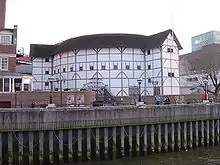
Southwark has many literary associations. Charles Dickens set several of his novels in the old borough where he lived as a young man. The site of The Tabard inn (featured in Chaucer's Canterbury Tales), the White Hart inn and the George Inn which survives.
The rebuilt Globe Theatre and its exhibition on the Bankside remind us of the area's being the birthplace of classical theatre. There is also the remains of the Rose Theatre. In 2007 the Unicorn Theatre for Children was opened on Tooley Street. The Southwark Playhouse is located in Elephant and Castle and the Union Theatre is located on Union Street near Southwark station. The Menier Chocolate Factory combines a theatre and exhibition space, whilst the newly opened Bridge Theatre is located next to Tower Bridge and City Hall.
Museums and galleries
The borough is the location of the Imperial War Museum in Borough High Street.[13]
Peckham Library, designed by Will Alsop won the Stirling Prize for modern architecture. Another architecturally innovative library designed by Piers Gough opened in Canada Water in 2011.[14] The Tate Modern is also based at Bankside.[15]
The Livesey Museum for Children was a free children's museum housed in the former Camberwell Public Library No.1, which was given to the people of Southwark by the industrialist Sir George Livesey. The museum was closed by Southwark council in 2008.[16]
MOCA, London, as curated by the artist Michael Petry, is a free museum located in Peckham Rye dedicated to exposing and showcasing new cutting-edge artists and their work.[17]
Economy
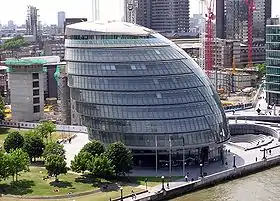
The northern end of the borough opposite the Square Mile includes the More London and London Bridge City developments accommodating the offices of major professional service firms. Notable such businesses include PricewaterhouseCoopers, Norton Rose, Ernst & Young, Lawrence Graham and Actis.[18] The Greater London Authority is based at City Hall.
The press and publishing industry is also well represented in Southwark; the Financial Times has its head office in Southwark Bridge Road,[19][20] IPC Magazines in Southwark Street, and the Evening Standard and Daily Mail at Surrey Quays. Campus Living Villages UK also has its head office in the borough.[21]
Some of the old industrial and wharfside heritage remains at the now defunct Surrey Commercial Docks now Surrey Quays, including Greenland Dock and Baltic Quay, where major residential schemes were developed in the 1980s and 1990s. Near Tower Bridge old warehouses have been converted to new mixed uses at Butler's Wharf and Hay's Wharf. Similarly, further west, the Oxo Tower hosts restaurants, shops and housing.
There are major retail concentrations at Surrey Quays, Old Kent Road, Elephant & Castle/Walworth Road and central Peckham.
Southwark is currently home to three Opportunity Areas (areas with capacity for significant economic development) as designated in the Mayor of London's London Plan.[22] These are Elephant and Castle,[23] Canada Water[24] and Old Kent Road.[25]
Educational establishments
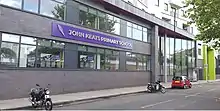
London South Bank University (LSBU) at its principal Elephant and Castle site has over 23,000 students and 1,700 staff. The Chancellor is the entrepreneur newscaster Richard Farleigh.
The University of the Arts London has two of its colleges in the borough – at Elephant and Castle is the London College of Communication and on Peckham Road is the Camberwell College of Arts.
The largest university teaching hospital in Europe King's College London is at the Guy's Hospital site, merging the teaching activities of the Guy's, St Thomas' and King's College Hospitals here. St Thomas' was founded in the mid-12th Century in the borough and parts of it remain at St Thomas Street; Guy's was founded opposite this in 1725. The Salvation Army maintains the William Booth Memorial Training College at Denmark Hill.
Housing
Southwark has a wide variety of housing, including council housing, such as the post-Blitz Aylesbury Estate and the Heygate Estate to provide homes to low-income residents. The aforementioned estates have been turned over to local housing associations to demolish and redevelop as mixed-tenure developments. Southwark Council and the Greater London Authority have invested tens of millions of pounds in supporting the respective housing associations complete these projects, which in both cases will lead to a large increase in the number of properties on the sites, with an almost equal reduction in the amount of social housing: the Aylesbury Estate originally housed 2,403 properties at social rent while post-development there will be 1,323 for social rent and 1,733 for private sale, meanwhile the Heygate Estate had 1,214 properties before demolition, most of which were leased at social rent, while the final plans for the development will see 2,530 homes of which 500 will be social housing.[26][27][28]
Southwark's local residents' returns recorded in 2011 that its rented sector comprised 53.4% of its housing, marginally below the highest in England, which was recorded by Camden, at 53.5%. In neighbouring Lambeth this figure was 47.3% and in neighbouring Croydon the figure was 29.7%.
Southwark had the greatest proportion of social housing in England, 43.7 (31.2% owned by the council itself with the other social housing in the hands of housing associations), at the time of the 2011 census.[29] Southwark's residents accordingly have developed Tenant management organisations covering many apartment blocks. The council own and set housing policy for a diverse range of Housing Association blocks to whom homes are allocated based on need and the rent that residents can afford, based on means testing. In some blocks a mixture of social, shared and sold housing is common, particularly in those where the right to buy has been exercised and in newer developments.[30]
| Ten highest-ranked local authorities by proportion of Social Housing-(2011 Census)[31] Note: First figure is total social rented (owned by housing associations and local authority, i.e. "the council"), the figure in parenthesis is council-owned only | |||
|---|---|---|---|
| Local Authority | Socially rented | Privately rented | Shared Ownership |
| Southwark London Borough | 43.7
(31.2) |
23.6 | 2.0 |
| Hackney London Borough | 43.7
(23.8) |
28.9 | 2.3 |
| Islington London Borough | 42.0
(26.7) |
26.9 | 1.3 |
| Lambeth London Borough | 35.1
(19.6) |
29.3 | 1.5 |
| Royal Borough of Greenwich | 34.3
(22.6) |
19.8 | 1.6 |
| Barking and Dagenham London Borough | 33.7
(28.4) |
17.7 | 1.3 |
| Camden London Borough | 33.1
(23.0) |
32.3 | 0.7 |
| South Tyneside Metropolitan District | 32.6
(25.2) |
9.0 | 0.4 |
| Norwich Non-Metropolitan District | 32.5
(26.2) |
21.7 | 0.7 |
| Harlow Non-Metropolitan District | 31.2
(26.9) |
10.8 | 0.9 |
Courts and judiciary
The old Southwark borough had been the location of many Courts and Prisons of Royal Prerogative, the Marshalsea and King's Bench. As well as the manorial and borough courts, magistrates met until the 20th century at the Surrey Sessions House which had its own jail for the punitive aspect of its work. The Inner London Sessions House (or now Crown Court) on Newington Causeway descends from these. The Southwark Coroner's Court in Tennis Street dates back to the charter of 1550. In 1964 Southwark Crown Court was opened at English Grounds near London Bridge. Since 1994 the Crown Court for west London Boroughs, was rehoused from Knightsbridge to Southwark as Blackfriars Crown Court. When the decision was taken to separate the judiciary and legislature, in 2007, by transforming the House of Lords Judicial Committee of Law Lords into the Supreme Court took over the court occupying the Middlesex Guildhall, whose City of Westminster judges transferred to Southwark Crown Court, hence the senior judge holds the honorific title of the Recorder of Westminster. Southwark's local magistrates sit at two courts in the borough, Tower Bridge and Camberwell Green Magistrates Courts.
The concentration of major courts, which are unlawful to film save for sentencing with judicial permission, enables their media coverage: Southwark has seven jurisdictions, six of which are London's criminal courts and which commonly receive offences committed in public office or in businesses based in Westminster and several other London boroughs.
Civic affairs
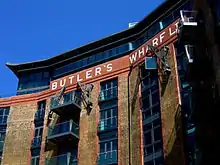
Mayor
The Mayor of Southwark for 2009–2010 was Cllr Tayo Situ (Peckham Ward), who was elected on 19 May 2010. He replaced Cllr Jeff Hook who served from 2009–2010. Cllr Tayo Situ died in office on 9 May 2011 from cancer. Under the civic and legal protocol he was given a full civic and ceremonial funeral and no replacement could be elected until then which delayed the Annual Council Assembly.
Cllr Charlie Smith was elected Mayor and Cllr Jamille Mohammed was appointed as Deputy Mayor in a civic celebration at Southwark Cathedral on Saturday 13 May 2017, incorporating The Southwark Civic Awards and Annual Meeting of the Council.
Cabinet
The council is run by a Leader and Cabinet Cabinet, chaired by council leader Cllr Peter John. Following the election in 2010 the Cabinet is Labour, replacing the previous Liberal Democrat and Conservative Party coalition.
Coat of arms
The two supporters on the coat of arms are an Elizabethan player dressed to play Hamlet to the left, indicating the theatrical heritage of the area, and the youth on the right side is the Esquire from Chaucer's Canterbury Tales. The coat of arms is an amalgam of elements of the three constituent Metropolitan Boroughs arms. The chequered band represents the three boroughs together. The cross was a common feature of Southwark and Camberwell. The well in the centre of the shield is a 'canting' reference to Camberwell and the cinquefoils represent the Dulwich area of Camberwell, while the ship on the top left refers to the maritime history of Bermondsey and was part of the Rotherhithe insignia. The rose on the right is from the Southwark arms where it represented St Saviour's parish, i.e. the Cathedral.
Politics
Southwark London Borough Council
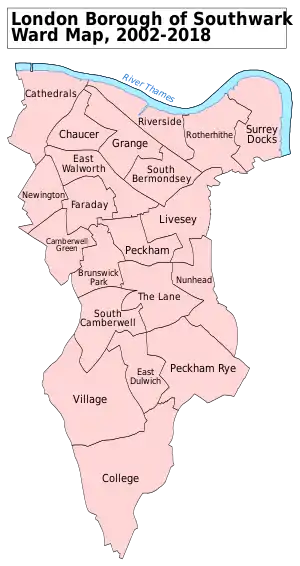
The borough currently has since 2010 a Labour Party-led council which has been the case in all but eight years since its formation. Previous control saw a four-year coalition of Liberal Democrats and Conservatives, during which as small minority members the latter held 2 of the 10 executive positions, including deputy leader.
Summary of council election results:
| Overall control | Labour | Lib Dem | Conservative | Others | |
| 2018 | Labour | 49 | 14 | 0 | 0 |
| 2014 | Labour | 48 | 13 | 2 | 0[34] |
| 2010 | Labour | 35 | 25 | 3 | 0 |
| 2006 | Lib Dem/Cons Coalition | 28 * | 28 * | 6 | 1 (Green) |
| 2002 | Lib Dem/No overall control | 28 | 30 | 5 | – |
| 1998 | Labour/No overall control | 33(31)** | 27 | 4 | 0(2)** |
| 1994 | Labour | – | – | – | – |
| 1990 | Labour | – | – | – | – |
| 1986 | Labour | – | – | – | – |
| 1982 | Labour | – | – | – | – |
| 1978 | Labour | – | – | – | – |
| 1974 | Labour | – | – | – | – |
| 1971 | Labour | – | – | – | – |
| 1968 | Labour | – | – | – | – |
| 1964 | Labour | – | – | – | – |
(*) Cllr Danny McCarthy (Cathedrals ward) defected from the Lib Dems to Labour after the 2006 election. Cllr Ola Oyewunmi (Peckham ward) did the reverse over one month to January 2010. Cllr Ade Lasaki (South Bermondsey ward) defected from the Lib Dems to Labour in March 2010. Cllr Susan Elan Jones resigned as councillor for The Lane ward to stand for MP to Clwyd South in Wales in the impending 2010 round of coinciding elections.
(**) Labour's candidates won 33 seats in 1998, of whom two resigned the whip to sit as independents, leaving no overall party-political control.
Westminster Parliament
The borough is covered by three parliamentary constituencies, all are currently represented by Labour MPs:
Sport and leisure
The London Borough of Southwark has the following sport clubs:
- Non-League football club Dulwich Hamlet F.C. who play at Champion Hill.
- Non-League football club Fisher F.C. who play at St Paul's Sports Ground, Rotherhithe.
Transport
Bridges and tunnels


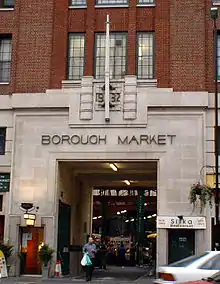
"A" Roads
- Roads leading to bridges across the Thames meet at St. George's Circus
- The A201 Inner Ring Road crosses the north-west of the area from the Elephant and Castle to Tower Bridge and the City.
- The A2 runs along Old Kent Road through the north of the borough and is London's main artery from the centre out to Kent.
- The A202 runs along Peckham High Street and passes the town hall.
- The A205 London's South Circular Road runs east-west along Dulwich Common and Thurlow Park Road in the south.
- The boundary with Bromley at Crystal Palace Parade is part of the A212.
London Underground (Tube) stations
The Bakerloo, Jubilee and Northern lines all run through the borough, below are the stations called at:
- Bermondsey (Jubilee line)
- Borough (Northern line)
- Canada Water (Jubilee line)
- Elephant & Castle (Bakerloo and Northern line (Bank Branch)
- Kennington (Northern line)
- London Bridge (Jubilee and Northern line (Bank Branch)
- Southwark (Jubilee line)
London Overground stations
- Surrey Quays
- Rotherhithe
- Canada Water (also part of London Underground)
- Denmark Hill
- Peckham Rye
- Queens Road Peckham
Railway stations
National Rail services in the Borough are operated by Southern, Southeastern and Thameslink.
- Gipsy Hill
- Denmark Hill (also part of London Overground)
- East Dulwich
- West Dulwich
- London Bridge
- North Dulwich
- Nunhead
- Peckham Rye (also part of London Overground)
- Queens Road Peckham (also part of London Overground)
- Sydenham Hill
- South Bermondsey
- Elephant and Castle
Riverbus piers
Operated by Thames Clippers
Parking and DVLA database ban
In 2012 it was revealed that the Southwark borough council has been permanently banned from accessing information from the Driver and Vehicle Licensing Agency. This information is normally made available to local authorities for purposes such as enforcing parking fines, but access can be withdrawn if they are found to be mis-using the service. The Big Brother Watch organisation, which obtained the information about the ban under a Freedom of Information request, claimed that "the public are right to be worried that their privacy is at risk across a range of government services."[35]
Travel to work
In March 2011, the main forms of transport that residents used to travel to work were: bus, minibus or coach, 17.5% of all residents aged 16–74; underground, metro, light rail, tram, 8.5%; train, 8.5%; on foot, 8.2%; driving a car or van, 8.1%; bicycle, 4.9%; work mainly at or from home, 2.8%.[36]
Places
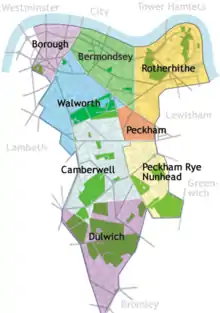
Localities
Parks and open spaces
- Southwark Park
- Burgess Park, (including trees at New Church Road)
- Dulwich Park
- Belair
- Long Meadow a.k.a. Belle Meadow
- Peckham Rye Park
- Russia Dock Woodland
- Sydenham Hill Wood
- Geraldine Mary Harmsworth Park, Lambeth Road, SE1. This park houses the Imperial War Museum although the Museum only owns the land directly in front of it, and the remainder is a public park.
- Nunhead Cemetery
- Newington Gardens ( Previously Horsemonger Jail Park. To locals Jail Park )
Notable residents (past and present)
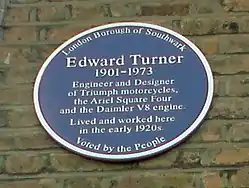
In 2003, the London Borough of Southwark started a blue plaque scheme for the commemoration of notable residents notably including living people in the awards.[37] The London Borough of Southwark awards Blue Plaques through popular vote following public nomination. Unlike the English Heritage scheme, the original building is not necessary for nomination.
Freedom of the Borough
The following people and military units have received the Freedom of the Borough of Southwark.
Individuals
- Lance Sergeant Johnson Beharry VC COG: 12 May 2012.
- Sir Michael Caine CBE: 12 May 2012.
- Rt Hon Dame Tessa Jowell DBE PC: 12 May 2012.
- Rt Hon Harriet Harman QC: 12 May 2012.
- Rt Hon Sir Simon Hughes: 12 May 2012.
Military Units
- 256 (City of London) Field Hospital (Volunteers): 30 June 2013.
- The Royal Marines Reserve (City of London): 30 June 2013.
- D Company The London Regiment: 30 June 2013.
- 2nd Battalion The Princess of Wales's Royal Regiment.
See also
- Southwark News local newspaper
References
- 2011 Census: Ethnic group, local authorities in England and Wales, Office for National Statistics (2012). See Classification of ethnicity in the United Kingdom for the full descriptions used in the 2011 Census.
- "Southwark". Oxford Learner's Dictionaries.
- "Southwark", in The Columbia Lippincott Gazetteer of the World (1952), New York: Columbia University Press.
- Mills, D. (2000). Oxford Dictionary of London Place Names. Oxford University Press.
- Johnson, David J. (1969). Southwark and the City. Oxford University Press. p. 7. ISBN 978-0-19-711630-2.
- Concise Oxford Dictionary of Place Names, Eilert Erkwall, 4th edition
- "Southwark: Total Population". A Vision of Britain Through Time. Great Britain Historical GIS Project. Retrieved 6 September 2011.
- "KS006 - Ethnic group". NOMIS. Retrieved 30 January 2016.
- "Ethnic Group by measures". NOMIS. Retrieved 8 January 2016.
- Religion in Southwark : London Archived 13 January 2012 at the Wayback Machine. theLondonArea. Retrieved on 17 July 2013.
- 2011 Census. Statistics.gov.uk (27 March 2011). Retrieved on 17 July 2013.
- Philby, Charlotte (12 December 2012). "Less religious and more ethnically diverse: Census reveals a picture of Britain today". Southwark.
- "Southwark WW1". Imperial War Museum. Retrieved 11 May 2020.
- "'Super library' in Southwark opens its doors". 28 November 2011 – via www.bbc.co.uk.
- "The Grand Southwark Showcase". Tate Modern. Retrieved 11 May 2020.
- Whittle, Adrian; Long Srikrotiam, Naomi. "Livesey Building FAQ". www.southwark.gov.uk. Southwark Council. p. 2. Retrieved 1 August 2014.
- "About us". MOCA London. Retrieved 11 May 2020.
- "Company Overview of Actis Capital, LLP" (Archive). Bloomberg Businessweek. Retrieved on 1 September 2014. "2 More London Riverside London, SE1 2JT United Kingdom"
- "London, United Kingdom." Financial Times. Retrieved on 28 October 2009.
- "Map." London Borough of Southwark. Retrieved on 28 October 2009.
- "Contact." Campus Living Villages. Retrieved on 5 October 2011. "Campus Living Villages UK Woolyard, 56 Bermondsey Street, London SE1 3UD, United Kingdom"
- "What are Opportunity Areas?". London City Hall. 20 November 2015. Retrieved 21 January 2019.
- "Elephant & Castle Partnership". Elephant and Castle. Retrieved 21 January 2019.
- "Canada Water". Southwark Council. Retrieved 21 January 2019.
- "Old Kent Road Regeneration - Home". Old Kent Road. Retrieved 21 January 2019.
- "Regeneration at Elephant and Castle and affordable homes Southwark Council". www.southwark.gov.uk. Retrieved 21 December 2018.
- Jones, Andy (13 April 2017). "Every Flat in a New South London Development Has Been Sold to Foreign Investors". Vice. Retrieved 21 December 2018.
- Turner, George (12 September 2018). "Revealed: London council took on financial risk of estate development". The Guardian. ISSN 0261-3077. Retrieved 21 December 2018.
- "Members list". Association of Retained Council Housing. Archived from the original on 4 September 2011. Retrieved 20 March 2011.
- "Leathermarket JMB". Leathermarket JMB. Retrieved 20 March 2011.
- Office for National Statistics 2011 Census Key Statistics: Tenure.
- "A Message from the Peace Commission: Information on Cambridge's Sister Cities," 15 February 2008. Retrieved 12 October 2008.
- Richard Thompson. "Looking to strengthen family ties with 'sister cities'," Boston Globe, 12 October 2008. Retrieved 12 October 2008.
- 2014 Results BBC News. Retrieved 13 November 2014
- DVLA bans councils from database over abuses, BBC News, 8 December 2012, retrieved 10 December 2012
- "2011 Census: QS701EW Method of travel to work, local authorities in England and Wales". Office for National Statistics. Retrieved 23 November 2013. Percentages are of all residents aged 16–74 including those not in employment. Respondents could only pick one mode, specified as the journey's longest part by distance.
- "Blue Plaque Winners 2007". Southwark Borough Council. Archived from the original on 13 September 2008.
- "Sir Michael Caine receives Freedom of the Borough of Southwark | Southwark Council". web.archive.org. 4 March 2016.
- "Freedom of the Borough presentation at St. George's Cathedral, Southwark". 12 May 2012 – via Flickr.
- "Latest News Southwark Council". www.southwark.gov.uk.
